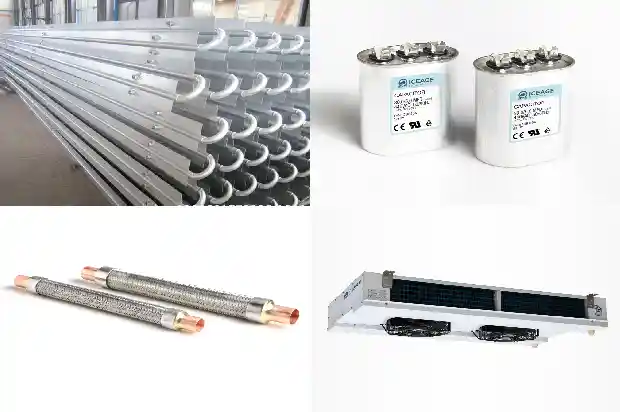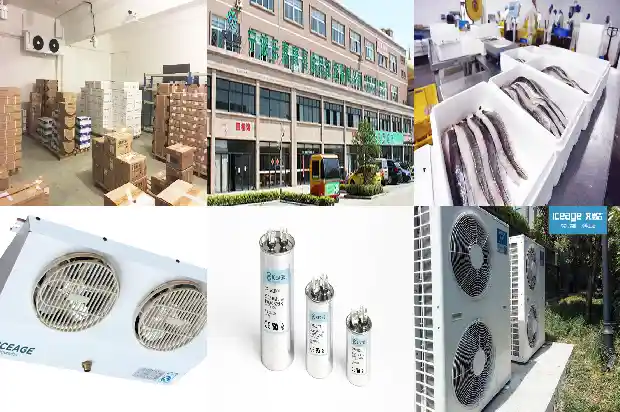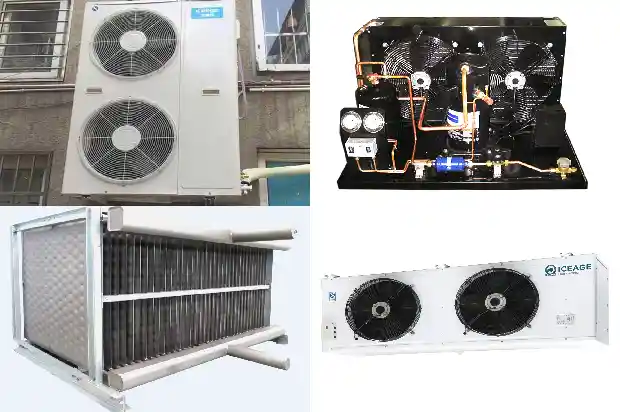How to Prevent Freezing for Air Conditioning Refrigeration Equipment?
2024-11-23
In winter, not only do we need to keep ourselves warm, but as people in the refrigeration industry, we also have to "take good care of" our refrigeration equipment. Especially in cold places, attention should be paid to taking anti-freezing measures for central air conditioners. In particular, for commercial central air conditioners in large venues such as shopping malls, manufacturing enterprises and hotels, how to prevent the air conditioning equipment from freezing? What are the anti-freezing measures?
Anti-freezing of the Main Unit
Close the inlet and outlet valves of the condenser or evaporator of the main unit, open the drain valve and the vent valve, and then use compressed air to blow out the remaining water completely.
Anti-freezing of the Water Pump
Close the inlet and outlet valves of the refrigerant water pump, open the drain valve and the vent valve of the water pump, and drain all the water. Open the valve at the lowest point of the cooling water system to drain the cooling water completely, and open the drain valve of the water pump. After the water in the system is drained completely, in order to prevent rainwater from entering through the cooling tower, close the total outlet valve of the cooling tower and open the sewage drain valve of the cooling tower sump so that the rainwater can be drained out in time through the sewage drain valve.
Anti-freezing of the Make-up Water Pipe of the Cooling Tower
Generally, the make-up water pipe of the cooling tower is exposed outdoors. Most designers adopt the insulation method to prevent freezing. However, in the actual use process, even with insulation, the phenomenon of freezing damage often occurs.
To solve this problem, when the make-up water pipe of the cooling tower is led out from the indoor area, an additional valve should be installed, and a drain valve should be added at the lowest point of the make-up water pipe. When winter comes, close the valve indoors and open the drain valve at the lowest point to drain all the water in the outdoor pipe. In this way, the pipeline does not need to be insulated and will not be frozen and cracked.
To solve this problem, when the make-up water pipe of the cooling tower is led out from the indoor area, an additional valve should be installed, and a drain valve should be added at the lowest point of the make-up water pipe. When winter comes, close the valve indoors and open the drain valve at the lowest point to drain all the water in the outdoor pipe. In this way, the pipeline does not need to be insulated and will not be frozen and cracked.
Anti-freezing of the Expansion Tank
The expansion tank is generally installed on the roof or in the equipment room on the top floor. Although the exterior of the expansion tank is insulated and equipped with a circulation pipe, in actual use, few circulation pipes can really play a circulation role.
To solve this problem, during construction, a DN20 interface can be set on the main water supply pipe of the air conditioner, and a valve can be installed and opened appropriately to ensure the circulation of the water in the tank. If the air conditioner is not used at night, before the water pump stops, this valve can be fully opened to increase the water temperature in the expansion tank, so that the expansion tank will not freeze for a long time after the pump stops.

To solve this problem, during construction, a DN20 interface can be set on the main water supply pipe of the air conditioner, and a valve can be installed and opened appropriately to ensure the circulation of the water in the tank. If the air conditioner is not used at night, before the water pump stops, this valve can be fully opened to increase the water temperature in the expansion tank, so that the expansion tank will not freeze for a long time after the pump stops.
Anti-freezing of the Fresh Air System
The function of the fresh air handling unit is to treat the outdoor fresh air and then send it to each room. In winter, the fresh air handling unit heats the outdoor cold air, that is, the surface cooler of the fresh air handling unit is in direct contact with the outside cold air. In order to prevent the surface cooler from being damaged by freezing when the heating is stopped, an electric multi-blade regulating valve should be added at the fresh air inlet and linked with the fresh air handling unit.


Adding Antifreeze
In winter, when it is inconvenient to drain and empty the unit and there is a possibility of water and power cut-off, it is necessary to add antifreeze for equipment heating. And the local minimum temperature must be taken as an important parameter for selecting antifreeze.
The main component of antifreeze is ethylene glycol. Antifreeze is poured into the make-up water tank. After draining the chilled water of the water system, first inject the original antifreeze solution. If it is not enough, then inject chilled water. Then start the water pump to make the antifreeze and water fully mix. By the way, all the air in the water system should be discharged. There should be no air in the water system. The existence of air will make the air conditioning equipment report the protection of the water flow switch and is also easy to cause cavitation.
The main component of antifreeze is ethylene glycol. Antifreeze is poured into the make-up water tank. After draining the chilled water of the water system, first inject the original antifreeze solution. If it is not enough, then inject chilled water. Then start the water pump to make the antifreeze and water fully mix. By the way, all the air in the water system should be discharged. There should be no air in the water system. The existence of air will make the air conditioning equipment report the protection of the water flow switch and is also easy to cause cavitation.
Insulating All the Chilled Pipes
The main purpose of insulating the chilled water pipes is to prevent condensation on the outside of the pipes. Another function is to prevent the water in the pipes from freezing. The thickness of the insulation layer is generally more than 20mm.
In addition, electric heat tracing tapes should be wound around the outside of the water pipes. As long as the heat tracing tapes are powered, they can continuously heat the pipes to keep the water temperature in the pipes above 10 °C. Coupled with the insulation on the outside of the heat tracing tapes, there will be no water shortage protection for the water heater caused by freezing. The heat tracing tapes should be selected with temperature limiters to maintain a certain temperature.
In addition, electric heat tracing tapes should be wound around the outside of the water pipes. As long as the heat tracing tapes are powered, they can continuously heat the pipes to keep the water temperature in the pipes above 10 °C. Coupled with the insulation on the outside of the heat tracing tapes, there will be no water shortage protection for the water heater caused by freezing. The heat tracing tapes should be selected with temperature limiters to maintain a certain temperature.
Case Analysis
Case 1: There was a villa user who didn't live in the house often. Last winter, when going abroad for vacation, the user cut off all the electricity and didn't drain the water. As a result, all the machines were frozen and damaged when coming back.
Analysis: The temperature was low in winter. Because the machines hadn't been used for a long time and the water hadn't been drained, all the machines were frozen and damaged.
Analysis: The temperature was low in winter. Because the machines hadn't been used for a long time and the water hadn't been drained, all the machines were frozen and damaged.
Case 2: In a rural area, the machines were frozen in winter, and the user called the engineer to go for maintenance.
Analysis: The temperature is very low in winter. If the anti-freezing measures are not done well, it is easy for the machines to be frozen. Water will freeze when the temperature is below 0 °C. When water freezes, its volume expands. And the expansion coefficients of pipes and water are different. So when the water temperature in the pipes is below 0 °C, the pipes may be damaged by freezing. When the ambient temperature is below 0 °C and the unit is not powered on or in the standby state, the internal anti-freezing protection fails.
Analysis: The temperature is very low in winter. If the anti-freezing measures are not done well, it is easy for the machines to be frozen. Water will freeze when the temperature is below 0 °C. When water freezes, its volume expands. And the expansion coefficients of pipes and water are different. So when the water temperature in the pipes is below 0 °C, the pipes may be damaged by freezing. When the ambient temperature is below 0 °C and the unit is not powered on or in the standby state, the internal anti-freezing protection fails.
Related Articles
- Why Can Air - Source Heat Pumps Be Damaged by Freezing? How to Prevent Freezing in Winter?
- Refrigeration System Circulation and Components for Freezing and Cold Storage
- Maintenance and Operation of Freezing and Cold Storage Warehouses
- Introduction to Key Points of Compressor Grouping in Quick-freezing Cold Storage
- Freezing Chamber System Blockage, Dirty Blockage, and Oil Blockage Characteristics and Treatment Methods
- Practical Knowledge on Freeze Protection of Air - conditioning Equipment
- Selection of Bypass Control Valves for Air - conditioning Water Systems
- Common Faults and Solutions of Central Air - conditioning Chiller Units
- Maintenance Techniques for Air - conditioning Refrigeration Systems
- How to Select and Use Water Pumps for Air - conditioning Systems?
- Essential Basics for Maintenance, Debugging of Refrigeration and Air - conditioning Systems
- Operating Principle and Standard Installation Steps of Multi - split Systems in Refrigerant Air - conditioning Systems
- Introduction to Various Water Tanks in Air - conditioning Systems
- How to Reduce the Energy Consumption of Central Air - Conditioning System through System Integration?
- Flowmeter for Refrigeration and Air Conditioning Testing
- What are the reasons for the inactivity of the automotive air conditioning compressor? What are the common faults?
- How to Check Refrigerant Leakage in Air Conditioning System?
- Air Conditioning System: Different Water Tanks
